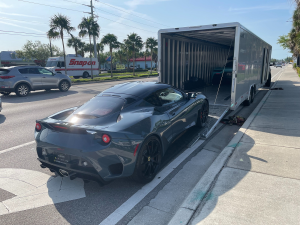How to Ship your Car at a Low Cost

Shipping your car can feel overwhelming, but with the right approach, you can make the process smoother and more affordable. Whether you’re relocating, buying a vehicle online, or sending a car to a loved one, understanding how ship your car at a low cost while ensuring a safe and reliable transport is key. Car shipping rates can vary significantly depending on several factors, and knowing how to navigate these costs can save you a considerable amount of money.
Plan Ahead for Lower Rates
One of the most effective ways to save on car shipping is by planning ahead. Booking your car shipment in advance allows you to compare different transport companies and choose the most cost-effective option. Last-minute arrangements typically come with higher fees due to limited availability and urgent scheduling demands. Carriers often increase prices when they need to fill last-minute slots quickly, so avoiding last-minute bookings can help you secure better rates. If your move is flexible, start researching car shipping services at least a few weeks in advance. This will allow you to take advantage of seasonal pricing fluctuations and promotions that some companies may offer for early bookings.
Choose the Right Type of Transport
When shipping a car, you generally have two main transport options:
- Open transport is the most common and affordable method, where vehicles are loaded onto an open trailer along with multiple other cars. While your car will be exposed to weather conditions, dust, and debris, this method remains a reliable and widely used option for everyday vehicles.

- Enclosed transport offers added protection from external elements, making it ideal for luxury, classic, or high-value cars. However, because enclosed transport accommodates fewer vehicles and offers enhanced security features, it comes at a higher cost.

If keeping costs low is a priority, open transport is usually the best option.
Compare Multiple Carriers and Get Quotes
Not all car shipping companies charge the same rates. Factors such as the distance of the shipment, the type of vehicle being transported, the time of year, and the company’s demand and availability all play a role in pricing. Taking the time to research and compare multiple providers can help you find the best deal. It’s a good idea to get at least three to five quotes from different auto transport companies to see how their prices and services compare.
Be Flexible with Pickup and Delivery Dates
If you can be flexible with your shipping schedule, you may be able to secure a lower price. Carriers often offer better rates for flexible shipping dates because it allows them to fill their trailers more efficiently. If you require guaranteed pickup and delivery on a specific date, you will likely pay a premium. By giving the transport company flexibility to fit your car into an existing shipment, you increase your chances of receiving a discount.
Consider Terminal-to-Terminal Shipping
Instead of opting for door-to-door delivery, you might want to consider terminal-to-terminal shipping. In this method, you drop off your vehicle at a designated terminal, and the carrier transports it to another terminal near your destination. Since terminal-to-terminal shipping does not require personalized pickup and drop-off services, it is generally a more budget-friendly option. However, before choosing this method, check the locations of the terminals. If they are too far from your home, the cost of traveling to and from the terminals may offset the savings.

Reduce the Car’s Weight to Lower Costs
Car shipping costs are often influenced by the weight of the vehicle. The heavier your car, the more expensive the shipping fee. To minimize costs:
- Remove unnecessary personal belongings from your vehicle.
- Empty the gas tank to a quarter full—enough for loading and unloading but not too much to add unnecessary weight.
- Take out roof racks, bike carriers, or other removable accessories.
Some carriers allow small amounts of personal items in the car, but excessive weight can lead to additional fees.
Avoid Peak Shipping Seasons
Car shipping rates tend to fluctuate throughout the year. During high-demand seasons, such as summer and the snowbird migration periods when retirees move between northern and southern states, prices are typically higher. If you have the flexibility to ship your car during an off-peak season when demand is lower, you may be able to secure a better deal.
Inspect Your Car Before Shipping
Before handing your vehicle over to the shipping company, conduct a thorough inspection and take high-quality photos. Documenting your car’s condition ensures you have proof in case of any disputes about damages upon delivery. Take photos of the entire car, including close-ups of any existing scratches or dents, and ensure that all lights and signals are functioning properly. Remove valuables and important documents, check tire pressure, and make sure the battery is charged to prevent any complications upon arrival.
Verify Insurance Coverage
Most car shipping companies provide insurance, but coverage levels can vary. Always ask about the details of the policy, including:
- What damages are covered.
- The deductible amount in case of a claim.
- Whether additional coverage is available if needed.
If you have a high-value car, purchasing extra insurance may be a good idea to ensure full protection during transit.
Common Mistakes to Avoid
To ensure a smooth and cost-effective shipping process, avoid these common mistakes:
- Waiting until the last minute – leads to higher prices and fewer transport options.
- Failing to check a carrier’s reputation – could result in poor service or hidden fees.
- Ignoring the fine print in your contract – may leave you unaware of cancellation fees, insurance policies, or unexpected delivery timeframes.
- Leaving personal belongings in your car – increases shipping costs and may complicate insurance claims.
Negotiating for Lower Prices
Many car transport companies are open to negotiations, especially if you’re shipping multiple cars or booking during a slow season. To improve your chances of getting a better price:
- Politely ask for a discount.
- Mention competitor quotes you’ve received.
- Offer flexibility in pickup and delivery dates.
- Inquire about ongoing promotions or deals.
Conclusion
Car shipping doesn’t have to be an expensive or stressful process. By planning ahead, selecting the right transport type, comparing providers, and maintaining flexibility, you can significantly reduce costs while ensuring your vehicle arrives safely. Checking for discounts, avoiding peak seasons, and reducing unnecessary weight in your car can further contribute to savings. With careful research and strategic decision-making, you can find a cost-effective way to transport your vehicle without unnecessary expenses. Taking the time to explore your options will help you secure the best possible deal for your car shipping needs.






1 comment